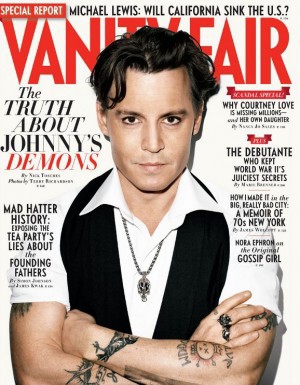The Week Of The Stuff
James Frey Explains Himself
You may think I’m a dick or arrogant or delusional or whatever, and frankly it doesn’t matter to me. I’ve written four books. Published in thirty-nine languages. I sold millions and millions and millions of copies. Do I want to be more famous? I could give a shit. Do I want to publish in more languages? There are a few left. What matters to me is a hundred years from now when people look back at our time, what writers are they gonna say, “Holy fuck!” I think I am and will be one of those people….
You keep saying “fiction” and “nonfiction”! Those words don’t mean anything to me. You think in today’s world there is some greater thing called truth? You know what’s truth? I’ll give you some fucking truth. Truth is when I watched my fucking kid die in my wife’s arms. That’s fucking truth. That’s truth. What happens here, what happens on the TV screen, that’s all fucking fiction!
'The Thing' Is A Replicant Sent To Suck All Joy From Monster Movies

Monsters aren’t inherently interesting. Sure, by virtue of their being strange and menacing and outside the periphery of normal existence, they’ll usually hold our attention for 90 minutes or so. But their scariness is all in the context and presentation. And just as it’s possible to take a transcendent ensemble cast and putrefy it by adding Eli Roth (yes, I’m still pissed about that), so is it possible to make an utter yawn-fest monster flick. Case in point: The Thing, which opens today.
I’m one of those assholes who can prattle on for days about the 1982 version — seriously, just ask anyone who’s gotten stuck talking to me. It’s often credited (correctly) as the first great creature film. John Carpenter took a weird little movie (the 1951 The Thing from Another World) and plopped in a fantastic script, perfect pacing, Kurt Russell, and the best creature effects that anyone had ever seen. No CGI, no digital enhancing, just some dudes with a truck full of clay and fake blood.
Then there were Carpenter’s characters: a research camp full of isolated men (not a woman in sight, which honestly didn’t matter) who quite literally become the monsters. Once the mysterious beastie appears and starts killing and replicating everyone, the characters are reduced to twisting, shrieking, blood-spurting bodies — coagulated simulacra of humans. Set this freakshow in a desolate Antarctic base, then add a paranoia-laced script and Russell at his nihilist best, and there’s your friggin’ great movie.
Of course, what most of us don’t admit is that the real scare in the 1982 version wasn’t the monster, but the spectacle of the human body itself. Who isn’t a little terrified of his or her own body? I mean, look at this thing that we’re forced to live in. It’s mercurial, temperamental, unpredictable; it rips and cracks and oozes and swells and shrinks and bleeds and turns various colors and emits any number of viscous liquids and rarely, if ever, gives you an explanation why. Our bodies have an agenda that is entirely separate from our conscious minds, and the two don’t always communicate well, or at all. In a sense, your body is the ultimate prison — it’s going to do what it wants, and you are stuck inside with no escape. When you think about it, it’s more terror inducing than a Perry-Bachmann ticket. Almost.
Cut to today, when we have director Matthijs van Heijningen Jr. essentially saying, “Hey, remember that Carpenter flick? That was good shit. So good, in fact, that we’re not even gonna attempt a remake. Instead, we’ll give our movie the exact same title, but call it a prequel, to indemnify ourselves from charges of unoriginal assholery. And then we’ll go make the exact same movie, only draped in layers of humorless mediocrity.”
The remake’s plot is a prosaic amplification of the 1982 film’s beginning, which opens with a helicopter trying to shoot a dog bounding across the snow. That opening is effective because it starts in media res. What Van Heijningen takes as his entire story was dispatched by Carpenter in a few minutes. Kurt Russell figures out that the dog comes from a Norwegian camp where everyone has been butchered by an alien capable of replicating its prey as a survival mechanism. Boom, done, plot explained, now let’s get to the escalating derangement of the surviving characters, and the attendant freaky gore.
The new version misses the point. We don’t need to know precisely what happened at that Norwegian base. And we certainly don’t need to spend 95 minutes exploring every detail. But hey, why not do it anyway, this time without a single iota of humor, suspense, or any of the elements that made the original great? Today’s cast is so dull, you want them to turn into the Thing simply so their faces will do something besides project a semi-comatose stupor. Mary Elizabeth Winstead puts her game face on as the paleontologist who figures things out, though even she walks around looking like she just popped two Klonopin. Granted, it’s not really a fair comparison. Kurt Russell can pull off perfect comedic timing while shooting a flamethrower, for Christ’s sake.
So yes, The Thing gets 1.5 chainsaws (out of five) for sucking all joy out of a horror classic. If you want a better scare, smash one of your digits in a door and watch what happens — now that’s terrifying.


Melissa Lafsky, The Awl’s Horror Chick, wants to be scared by your movie.
The Best New TV Show of the Fall Season
The Best New TV Show of the Fall Season

For some reason I decided to take this fall TV season with terrible seriousness and I dutifully set my DVR for all the new offerings. Most of it was easily discarded by the second episode. (So thank goodness for some returning shows; “Bored to Death” is again absolutely awesome.) “Pan Am” is soulless and dreadful and slow. “Prime Suspect” is great to watch and incredibly edited and makes New York City look fun and gritty, but still when it comes up on the recorded shows list, it rings no emotional bells. “Charlie’s Angels,” good grief, I turned off the pilot 20 minutes in, it’s despicable. (And so long forever!) “Terra Nova” comes off as very simple-minded, it’s pitched for blockheads, but I’ll keep watching because it’s impressive how much money they’re willing to spend. “Person of Interest” came on way too strong. “The Secret Circle” started off entertaining and trashy but you pretty much can’t stick with it if you’re not 15, it’s pitched intellectually somewhere beneath the “The Vampire Diaries,” which is really saying something. Otherwise, I’m not watching any of the comedies because I’m humorless — maybe some are good! — and “Enlightened” I am hoarding so I can consume all its Laura Dernitude at once. And then there’s one show, one show that should be reviled and mocked and has no right to be considered good, and so far it’s absolutely the best thing around. Somehow, “Revenge” punches all the pleasure centers all at once.
If you haven’t seen, the gist is: once upon a time, a young girl’s very wealthy father was set up by his married lady-lover and a full-blown conspiracy of rich evil people. He goes off to jail (for TREASON no less!) and the girl grows up in institutions, and then finally inherits all of the father’s millions (somehow; that’s unlikely and vague), returns to the Hamptons under a different identity and name, and immediately spends her summer vigorously destroying all of them.
Part of what makes what should be an odious night-time soap successful, apart from how well it relays its cruel adventures, is casting; the lead, played by a Canadian named Emily VanCamp, does polite socialite, romantic damsel, hurt girl and incredibly evil mercenary equally well, all with just a twist of her flat face. She pulls the show off super-quietly, and lets the histrionics go on around her. Her nemesis is the astoundingly chilly, chilly, chilly Madeleine Stowe. Her love interest (real? Or ploy?) is this absurdly Kennedy-esque nobody hunk from England, Joshua Bowman. (Who was a friend of Amy Winehouse’s? Huh.) Couldn’t be better, down to the extras. (Except maybe for the casting of the dog.)
But the real success comes from a really elegant little tap dance of being both appealing luxe (money is so fun!) while also being about the glorification of the destruction of the rich. The helicopter shots of the Hamptons! The ridiculous real estate! The pool houses! The interiors are perfect; the outfits are terrific. It scratches that gross rash where everyone loves an enormous house and also the slightly less but still gross rash where we love seeing evil people get dragged under.
And the third ingredient is pure trashy camp of the classic evening soap variety, but of the highest order. Meanwhile, the show also reaches out to stroke all our little tinfoil hats: of course conservative Senators have affairs and children out of wedlock, and everyone’s corrupt, and it goes without saying, in this mindset, that all rich people got where they are by evil deeds. That this isn’t really strictly true in the real world is beside the point. Now (again and more) we all think the worst of rich people.
Le Comte de Monte-Cristo ran in 18 serial installments, over the course of a year-and-a-half; it seems inconceivable that “Revenge” could hold up for 22 weekly episodes, as was just (finally!) ordered by ABC, but such is the magic of television when it’s actually magical.
Nas, "Nasty"
Since his all-time classic debut album Illmatic came out in 1994, Nas has all-too rarely sounded as hungry and as honest and as at ease with his prodigious rhyme skills as he did when he said, “When it’s real, you’re doing this even without a record contract.” Unfortunately, since he got a big record contract and accepted the pressure to make big radio hits and sell millions of albums, he’s not well-suited for the sort of high-end production with melodic choruses that tends to enable that. He’s better over simple, less-adorned breakbeats. (The kind rappers tend to rap to even without a record contract.) Fortunately, for his oldest fans at least, his latest single, produced by frequent collaborator Salaam Remi, features the latter — with a wordless chorus that’s basically three notes of horns that might’ve come from a ’60s cop show. And he even made a good video for it!
Celebrities And The "Rape" Of Photography
by Soraya Roberts

Johnny Depp took his reputation for eccentricity a little too far last week. Interviewed in the November issue of Vanity Fair, the actor appeared to let his guard down when discussing photo shoots with writer Nick Tosches, a long-time friend and a godparent to one of Depp’s kids. “Well, you just feel like you’re being raped somehow,” the actor said. “Raped. The whole thing. It feels like a kind of weird — just weird, man. Weird. Like you meet people and they say, ‘Can I have a picture with you!’ And that’s great. That’s fine. That’s not a problem. But whenever you have a photo shoot or something like that, it’s like — you just feel dumb. It’s just so stupid.”
Depp isn’t the first actor who’s had to apologize for comparing photography to sexual assault. Just last year, Kristen Stewart told Elle UK that seeing photos taken of her by the paparazzi felt like “looking at someone being raped.” It’s an extreme reaction to the medium, and one that Susan Sontag addressed in her seminal On Photography, in which she argued that, while images can be violated, the people on whom those images are based cannot. “One can’t possess reality, one can possess images,” she wrote. But in Hollywood, a world where image is everything, how do you tell where reality ends and image begins?
The answer is clearly not provided on the big screen. On the contrary. Interestingly, Depp uses the term “stupid” at least a couple other times in the interview. One of them comes when he’s describing his opposition to a staged cockfight in the upcoming film, The Rum Diary. Though the cockfighting scene reportedly looks real, the roosters were protected from killing each other with pieces of invisible monofilament (in accordance with American Humane Association regulations), a precaution he appeared to think detracted from the viscerality of Hunter S. Thompson’s original scene. “I think it was stupid,” he told Tosches. Extrapolating from that comment, Depp use of the term “stupid” suggests his aversion to false representation. Given his stated pleasure at being photographed by fans in his everyday life, it’s the falseness of the photo shoot and the poses associated with it that seem to bother Depp.
I

n this, Depp brings to mind Diane Arbus’ “freaks,” who remain some of the most extreme examples of the falsely represented. In On Photography, Sontag refers to the technique used by Arbus, famed documenter of New York’s marginalized (dwarfs, giants, transvestites, nudists etc.): “Instead of trying to coax her subjects into natural or typical position, they are encouraged to be awkward, that is, to pose. Thereby, the revelation of self gets identified with what is strange, odd, askew. Standing or sitting stiffly makes them seem like images of themselves.” In a similar way to Arbus’ subjects — whose real selves are undermined by the images the photographer wishes to present of them — Depp subverts his own persona and projects that of the various fashion photographers who shoot him for magazines. In this way Depp maintains the Hollywood illusion of himself as poster boy for celebrity eccentricity.
The photographer’s power lies not only in determining how his or her subject poses, but also in how the image is ultimately produced (cropping, editing, Photoshopping, etc.); as Sontag put it, “in preferring one exposure to another, photographers are always imposing standards on their subjects.” Small wonder that Julia Roberts could tell American Photo in 2004 that she feels “stupid,” “goofy,” and “nervous” — like Depp — when being photographed and, in the same breath, say that when she handles a camera (as in the film Closer, in which she played a professional photographer), it “instantly makes you the coolest person in the room.”
Other celebs try to wrest control back from the cameraman. When I interviewed Shirley MacLaine a few years ago on the set of the TV movie Anne of Green Gables: A New Beginning, during our photo shoot, she chose the position in which she sat and dictated the light and filters the professional photographer was expected to use. Using a different tack, Lady Gaga caused a stir in March when she issued a release form demanding that concert photographers sign over to her the rights to all their photos taken at her shows.
Slightly harder to control are the rabid paparazzi photographers that have proliferated in Hollywood over the past decade. Popular targets have taken to disguising themselves, holding up signs (see Scarlett Johansson’s famous “I’m being harassed by the person taking this picture” sign), running from location to location, and sometimes even attacking the photographers who are following them (cf. Sean Penn and Woody Harrelson). But besides the immense danger the celebrities (and passersby, on foot and in vehicles) face in being mobbed, these off-duty stars also appear to be fighting what Sontag refers to as the democratization of their experiences.

“A way of certifying experience, taking photographs is also a way of refusing it — by limiting experience to a search for the photogenic, by converting experience into an image, a souvenir,” she wrote. In short, part of what these stars may be objecting to is their day-to-day experiences being nullified by the paps that are falling all over themselves to snap them for our viewing pleasure.
“Why would I want anything that’s private to become entertainment for other people?” the infamously camera-shy Kristen Stewart seemed to ask for all celebrities in that 2010 interview with Elle UK. At the height of her Twilight fame, she was so used to her experiences being captured by journalists and photographers both that during the interview she hesitated before removing an iPod from her car’s glove compartment to show the journalist her music. “You want to be excited about something, normal people can be excited about their lives, and I am too, but it’s such a different thing,” she explained of her hesitation. “It comes out as entertainment for other people and that makes me want to throw up.”
Explaining her moodiness around paparazzi, Stewart contended that the public is not often privy to what happens before the pictures are taken. “What you don’t see are the cameras shoved in my face and the bizarre intrusive questions being asked, or the people falling over themselves, screaming and taunting to get a reaction,” she told Elle. “All you see is an actor or a celebrity lit up by a flash. It’s so… The photos are so… I feel like I’m looking at someone being raped.”
In her book, Sontag anticipated this type of comparison, stressing that photography requires distance while attacking someone sexually requires proximity. “The camera doesn’t rape, or even possess, though it may presume, intrude, trespass, distort, exploit, and, at the farthest reach of metaphor, assassinate — all activities that, unlike the sexual push and shove, can be conducted from a distance, and with some detachment,” she wrote. Though the use of “push and shove” does conjure images of photographers clamoring to snap Stewart, the sexual aspect of the action is missing.
In the same interview, Stewart did, however, seem to be in tune with Sontag. “Your little persona is made up of all the places that people have seen you and what has been said about you, and usually the places that I am are so overwhelming in the moment and fleeting for me — like one second where I’ve said something stupid, that’s me, forever.” The words conjure up Sontag’s suggestion that “the force” of a photo is such that it allows viewers (including Twilight fans) to scrutinize “instants which the normal flow of time immediately replaces.” So, one image of Stewart grimacing at a crowd of paps, or a moment in which she says the word “rape,” reverberates across the universe and single-handedly becomes her undoing.
Though the camera doesn’t “rape,” it does “violate” its subjects, but according to Sontag, it’s only a figurative violation “by having knowledge of them they can never have.” Stewart herself cannot be possessed but as the subject of a photograph, an object that can be physically held, she is “symbolically possessed.”
This so-called symbolic possession becomes all the more realistic when you consider the way photography works, which Sontag explained as “never less than the registering of an emanation (light waves reflected by objects) — a material vestige of its subject.” Because of this, images can “usurp reality” since it is essentially “a trace, something directly stenciled off the real.” Sontag concluded by stating that the photograph being an extension of the subject captured, the image becomes a kind of means of acquiring the subject.
The statement gives a literal bent to Sean Penn’s comment in Playboy in November 1991 in which he described himself and Madonna as “public property.” It also makes Keira Knightley’s 2007 Crocodile Dundee-style, quasi-spiritual fear of being photographed appear slightly less ridiculous. “I’m not comfortable having to be myself or being photographed as myself,” she said. “Australian Aborigines say that with every photo that is taken, a piece of your soul goes with it. And there are some days when I kind of believe that.”
But Sontag’s book rebuts the idea that photography has the power to capture a piece of one’s real soul. “It is not reality that photographs make immediately accessible, but images,” she wrote. What’s confusing to celebrities (and much of the rest of the world) is that our era confounds reality with photographs. “Instead of just recording reality, photographs have become the norm for the way things appear to us, thereby changing the very idea of reality, and of realism,” Sontag claimed, adding that the “true modern primitivism” is not to consider the image real, but to consider reality an image that can only be realized through photographs.
Unfortunately, the only way to combat this primitive behavior, Sontag argues, is to see the photograph for what it really is, not a real instance of power, but merely a weak expression of it — as it is a weak expression of the real Depp and the real Stewart, and as such is no real replacement for the stars themselves or their bodies. “The knowledge gained through still photographs will always be some kind of sentimentalism, whether cynical or humanist,” Sontag explained. “It will be knowledge at bargain prices — a semblance of knowledge, a semblance of wisdom; as the act of taking pictures is a semblance of appropriation, a semblance of rape.”
Soraya Roberts is an entertainment writer and editor. She writes about films on her blog, Incinerater. She is also on Twitter, much to her dismay.
Photo of Stewart by Joe Seer, via Shutterstock.
Britons Filthy
It is probably safer to be stabbed by a British person than it is to borrow his mobile phone. Knives, at least, get cleaned.
Big Boi Reenacts Classic Scene From 'Animal House' In Miami Courtroom
Millions-selling, Grammy-award winning, penguin and Kate Bush-loving rapper Big Boi appeared in a Miami court room yesterday to accept a plea deal in lieu of jail time for the felony drug charges he received after being arrested upon disembarking a cruise ship in August. If he passes three months of drug testing, completes fifteen hours of community service, and donates $2,000 to charity, the charges will be dismissed. Between the outfit he chose to wear to court, though, and his unsolicited sign-off at the end of the proceedings, it seems like he was maybe having a bit of fun at the expense of Dean Wormer and Greg Marmalard.
Michigan Bigfoot Definitely Not Jewish
“A Michigan woman says she feeds a bigfoot family blueberry bagels.”
As American As Xbox and Fried Chicken
by David Roth and David Raposa

David Roth: Read any good overhyped pseudo-exposes this week?
David Raposa: God, after that Globe “exclusive,” I don’t know if I can take any more hard truths. BASEBALL PLAYERS DRINK BEER AND PARTAKE OF UNHEALTHY FOODSTUFFS. MIDDLE-AGED MAN WITH KNEE PROBLEMS TAKES PAIN MEDICATION. SUBPAR EFFORTS FROM HITTERS AND PITCHERS LEADS TO LOSSES. (I am actually yelling those as I type.)
David Roth: I know, I can hear you. I think John Lackey eating a lot of Popeye’s is sort of the opposite of “scoop.” The tales of same are well-sourced and all that, but I already knew as much. Dude looks like a peevish curly-fry, so I could guess that much of what he eats falls under the “Golden Brown” heading.
David Raposa: Aside from the checks he was cashing, the man had a shitty year all around. I don’t begrudge him a little comfort food and some “Halo.” But I will definitely grudge the hell out of the notion that this story was “well-sourced.”
David Roth: I don’t think they should have written it or run it. Obviously people in the region wanted to read it, and the Internet loves to hate it, but the All The President’s Men ponderousness of it is vicious self-satire, for one thing. And the idea of the reporters calling Jason Varitek at home to ask him to confirm or deny the popularity of massive-multi-player gaming among the pitching staff is wince-city for me.
David Raposa: “When reached for comment, Hal Holbrook had this to say: ‘The most outrageous lies that can be invented will find believers if a man only tells them with all his might.’”
David Roth: Also and more to the point, that whole thing could’ve been rewritten with a “these lovable rogues” slant if the team had won like two more games in September. Could’ve and would’ve been.
David Raposa: Exactly. Imagine if Seattle or Baltimore’s sports journalists were as fixated on making sense of it all as Boston’s were.
David Roth: I really, really want to read a similarly deep/dense story about the Orioles locker room. Luke Scott and Hank Williams Jr. just hanging out in there during games, firing handguns into the air and ranting about the United Nations and “Barry Soetoro.”
David Raposa: EXCLUSIVE: DANIEL CABRERA NOT A GOOD PITCHER, HAS ANGER ISSUES. OVER-THE-HILL VETERANS FAIL TO RECREATE CAREER-BEST PERFORMANCES. (OK, my upstairs neighbors just told me to quiet down.)
David Roth: Also, that story could probably be written about any team, right? The only thing that keeps us from knowing about a towel-clad, Old Crow-sodden Clint Barmes driving an ATV around the Astros locker room after games is the fact that no one cares to write about it.
David Raposa: Except up here in the Northeast!
David Roth: Presumably WEEI is calling for Congressional hearings?
David Raposa: It’s really not so much All The President’s Men as it is some third-rate jingoistic conspiracy thriller starring Caspar Van Dien, F. Murray Abraham, and a former Suicide Girl.
David Roth: Now that the Red Sox have managed to free themselves of the manager and GM that helped them win those two World Series, do you think they’ll finally be able to accomplish something?
They want most what they can’t have: a World Series win against the Yankees. Achieved after going 162–0 against the Yankees. And sweeping the Yankees in every possible pre-Series playoff scenario a hyper-caffeinated Bud Selig can concoct.
David Raposa: Gosh, I hope so! Going into the playoffs every year with nothing to show for it sure got stale! It was like being a Yankee fan. It’s actually kind of reassuring to see that the good old Red Sox Inferiority Complex is not only alive and well, but absolutely thriving.
David Roth: I hate to put you in the position of soothsaying for a multi-state region of total maniacs, but what do Sox fans actually want? To win a World Series with Larry Bird, Casey Affleck and Carlton Fisk as co-GMs?
David Raposa: They want most what they can’t have: a World Series win against the Yankees. Achieved after going 162–0 against the Yankees. And sweeping the Yankees in every possible pre-Series playoff scenario a hyper-caffeinated Bud Selig can concoct.
David Roth: Including candlepin bowling and a contest to see which team “gets the most out of” the Sam Adams brewery tour.
David Raposa: I would love to see a Yankees-Red Sox World Series of Competitive Eating, just to see what the posting fee would be to negotiate with Takeru Kobayashi.
David Roth: I think Theo Epstein is really going to enjoy running the Cubs. Less demanding drunks in the stands, and Marlon Byrd and Darwin Barney swapped in for Ellsbury and Pedroia. Should be great!
David Raposa: I love how Epstein’s legacy seemingly went from “breaking The Curse, building a de facto dynasty and establishing one of the best farm systems in all of baseball” to “lol Carl Crawford” after one bad month.
David Roth: Totally. I think the Mets would be happy to discuss a Crawford for Jason Bay swap if the Sox were looking to get some more grit out there.
David Raposa: I thought the Sox let Bay walk because he was “too Canadian?” (And if it’s an issue of needing grit, I’m sure Darin Erstad is near his flip-phone, breaking rocks with his forehead.)
David Roth: In terms of run production, Bay has been “too Belgian” with the Mets. Also, Erstad keeps in shape by running into his garage door at full speed for 45 minutes each morning.
David Raposa: On the Theo tip, I am very much looking forward to that Lackey/Zambrano challenge trade. Boston wouldn’t mind having Z around: you’d have a built-in scapegoat for all clubhouse issues, and you wouldn’t have to worry about other players noshing on greasy grub between innings.
David Roth: The only thing I am concerned about now, baseball-wise, is Tony La Russa getting back to the World Series. If that doesn’t happen, I’m pretty much good.
David Raposa: You mean LEGENDARY HALL-OF-FAME MANAGER Tony La Russa. There but for the grace of Lance Berkman’s dietician and Kyle Lohse’s emery board…
David Roth: As long as they beat the Cardinals and spare me another couple weeks of La Russa’s Bruce-Jenner-pickled-in-vinegar self scowling through a pitching change, the Brewers can do whatever they want. Replace Yovani Gallardo with Governor Scott Walker. Add Latrell Sprewell to the postseason roster. Whatever, I will be in their debt.
David Raposa: Meanwhile, Bruce Jenner looks like what would happen if you soaked Tom Cruise in egg drop soup and X-Acto knives for a year.
David Roth: Why must we immerse our most admirable males in liquid? That is the thing that annoys me the most about America right now. That and LaRussa using four pitchers to get three outs and having a bench made up entirely of Nick Puntos.
David Raposa: Have you seen Nick Punto’s line this year?!? He’s absolutely Ecksteinian! In the good way! (That’s totally due to Tony La Russa using him effectively against every team’s long-relief man)
David Roth: Here are the requirements for being on Tony La Russa’s bench: 1) Slugging percentage of .325 or lower, 2) Western/Southern Europe ancestry, 3) 5’7″ or shorter, 4) Being cool with late-night phone calls from La Russa that begin “I can’t sleep. I’m too mad about illegal aliens.”
David Raposa: Don’t forget 5) Can play catcher when TLR uses his 3rd-stringer as a pinch-runner in the 5th inning. Are one-syllable first names also a pre-requisite, or am I confusing that with his 2B specifications?
David Roth: Anyone can get those confused. You shouldn’t feel bad about it.
David Raposa: EXCLUSIVE: In the St. Louis clubhouse, Jon Jay and Allen Craig play Jenga naked before games while Jake Westbrook drinks St. Ides and listens to “hip-hop music.”
David Roth: And that is what makes them champions. Such a thin line between “fucking idiots” and “The beloved World Champion ‘idiots’” I miss when “idiot” was just a short way of saying “Johnny Damon.”
David Raposa: It all comes back to hair. Cut off La Russa’s executive bowl cut and he turns into Stump Merrill. And Albert Pujols becomes Oscar Azocar.
David Roth: Oscar Azocar! I remember having a Baseball Prospectus, and Azocar’s entry was all jokes about him. I’m pretty sure I’m not making this up.
David Roth: They had the Loves To Face/Hates To Face for every hitter. For Azocar they had whoever he Hated To Face — Jose DeLeon or Rick Rhoden or some other janitor-looking 1980s chucker — and then “Loves To Chase: Bad Pitches.”
David Raposa: That sounds about right.
David Roth: And then something about “Are your legs tired? Drive an Azo-Car and you’ll never walk again!”
David Roth: I don’t remember if they had those for other players. Like if the Loves To Face for Ron Karkovice just read: “Hahahahaha”
David Raposa: Only a player with Azocar’s particular “skill set” could inspire such greatness. The only other guy that might have a comparable Laughs Above Replacement Player (LARP) is Sidney Ponson.
I’m quoting a United Nations resolution, here: “It is rare that the General Assembly votes unanimously on any measure, but we all just kind of get that Sidney Ponson can’t be trusted with a Ski-Doo, even under professional supervision.”
David Roth: Oh, Sir Sid. He is one of the only people in the world not allowed to rent a jet-ski. Anywhere. Only North Korea will rent him one, and the only one they have is in Kim Jong Il’s penis-shaped pool of single malt scotch, so…
David Raposa: If Kim Jong Il had such a pool, I’m pretty sure Sidney would just belly flop into that thing naked and drain it in about 45 minutes. While rectally inhaling 7–11 taquitos.
David Roth: I’m quoting a United Nations resolution, here: “It is rare that the General Assembly votes unanimously on any measure, but we all just kind of get that Sidney Ponson can’t be trusted with a Ski-Doo, even under professional supervision.” That is why you can’t invite him to your house. Or nation. Royals fans already know this.
David Raposa: I’ll just have to award him the key to the great city of Hartford via Skype.
David Roth: So, what are the teams you actually want to see in the World Series? Mine are the Brewers and Rangers. But, like, the 1982 Brewers and the Rangers teams that were built around Rusty Greer. The 1980s Brewers were the greatest. They all looked like a different type of embarrassing stepdad.
David Raposa: I get a kick out of those MLB promos that show Brewers past and present. Because when I think of those ’80s Brewers squads, I think of Yount, Molitor… and Don Sutton?
David Roth: I personally think of Sutton as a more embarrassing prospective stepdad than Gorman Thomas. But both are not anyone you want saying, “I want you to start calling me ‘Dad,’ okay, sport?”
David Raposa: “Hey, champ. I saw you were listening to the radio while we went to get our weekly Fribble, so I bought you this Juice Newton LP!”
David Roth: There is a lot I didn’t know about Gorman Thomas, apparently. Beginning with the fact that he 1) played CF on that Brewers team and 2) apparently loved trying to steal bases despite being built like a London Broil.
David Raposa: He contains multitudes. In his handlebar moustache.
David Roth: For his career, Gorman stole 50 bases and was caught 49 times! So he finished his career in the positive. That’s great.
David Raposa: A caught-stealing’s as good as a 4–3 putout to a slow man.
David Roth: His best seasons were the best seasons. I wish they still made .244–42–135 seasons, with 175 strikeouts, a .535 slugging percentage, and one steal against five caught-stealings.
David Raposa: Well, he might not drive in as many guys, or run as poorly, but feast your eyes on The Future! Which is the near-present!
David Roth: Ah, good point. Although Thomas wasn’t half the base-stealing threat (?) that Adam Dunn is.
David Raposa: According to team sources, Dunn “runs well for a big man,” but likes to “pick his spots.”
David Roth: He also “looks and runs like Will Ferrell.” Not that I’m mad about that. Watching sluggers Go Gelatinous is one of the great joys of following baseball over the long term. Miguel Cabrera is basically turning into a manatee before our eyes.
David Raposa: And he’s still good for what he’s getting paid to do. As long as he doesn’t overextend himself. While tying his shoes. (I kid because I, too, break out into a not-so-cold sweat while rising from the seated position.)
David Roth: You still look healthier than Joe Buck sounds. And judging by the whuuut-is-happening face he makes after high-fiving Tim McCarver, Buck isn’t feeling that great, either.
David Raposa: I dunno, Buck actually sounded somewhat engaged when Tito was in the booth. Maybe Tito brought along a pre-release copy of Arkham City?
David Roth: Yeah, he was more awake than usual. I’m just worried about him, I guess. I think he should take a few years off. Twitter has already given us the spectacle of Buck traveling through time, underselling various historical events. He should focus on that.
David Raposa: He needs to go DIY and make his own show.
David Roth: Webisodes.
David Raposa: Animated webisodes. From the folks that made that Sports Guy cartoon.
David Roth: Yes, more from the people behind the Sports Guy Cartoon, please.
David Raposa: Would you rather the Anderson/Smoltz/Darling combo be responsible for promoting “Terra Nova”?
David Roth: Buck does seem uniquely well-suited for that particular gig.
David Raposa: He puts the “null” in “consummate professional.”
David Roth: He puts the “flu” in “mellifluous.”
David Raposa: He puts the “der” in “ponderous.”
David Roth: QUIPS.
David Raposa: From the minds that gave you “Skin” and “K-Ville”! This fall on Fox!
David Roth co-writes the Wall Street Journal’s Daily Fix, contributes to the sports blog Can’t Stop the Bleeding and has his own little website. And he tweets!
David Raposa writes about music for Pitchfork and other places. He used to write about baseball for the blog formerly known as Yard Work. He occasionally blogs for himself, and he also tweets way too much.

